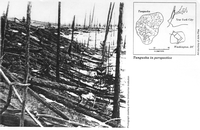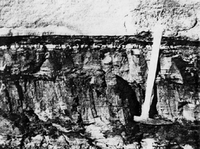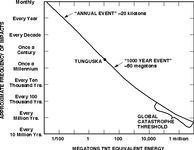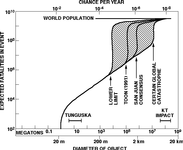
Chapter 2: Hazard of Cosmic Impacts
2.1 Introduction Throughout Its history, the Earth has been impacted by countless asteroids and comets. Smaller debris continually strike Earth's upper atmosphere where they burn due to friction with the air; meteors (which are typically no larger than a pea and have masses of about a gram) can be seen every night from a dark location if the sky is clear. Thousands of meteorites (typically a few kilograms in mass) penetrate the atmosphere and fall harmlessly to the ground each year. On rare occasions, a meteorite penetrates the roof of a building, although to date there are no fully documented human fatalities. A much larger event, however, occurred in 1908 when a cosmic fragment disintegrated in the atmosphere over Tunguska, Siberia, with an explosive energy of more than 10 megatons TNT. But even the Tunguska impactor was merely one of the smallest of Earth's neighbors in space. Of primary concern are the larger objects, at least one kilometer in diameter. Although very rare, the impacts of these larger objects are capable of severely damaging the Earth's ecosystem with a resultant massive loss of life. In the following discussion, we examine the risks posed by impacting objects of various sizes. These projectiles could be either cometary or asteroidal. In terms of the damage they do, it matters little whether they would be called comets or asteroids by astronomical observers. We term these objects collectively NEOs (Near Earth Objects). Every few centuries the Earth is struck by an NEO large enough to cause thousands of deaths, or hundreds of thousands of deaths if it were to strike in an urban area. On time scales of millennia, impacts large enough to cause damage comparable to the greatest known natural disasters may be expected to occur (Pike 1991). Indeed, during our lifetime, there is a small but non-zero chance (very roughly 1 in 10,000) that the Earth will be struck by an object large enough to destroy food crops on a global scale and possibly end civilization as we know it (Shoemaker and others 1990). As described in Chapter 3, estimates of the population of
NEOs large enough to pose a global hazard are reliable to within
a factor of two, although estimates of the numbers of smaller
objects are more uncertain. Particularly uncertain is the significance
of hard-to-detect long-period or new comets, which would generally
strike at higher velocities than other NEO's (Olsson-Steel 1987),
although asteroids (including dead comets) are believed to dominate
the flux. However, the resulting environmental consequences of
the impacts of these objects are much less well understood. The
greatest uncertainty in comparing the impact hazard with other
natural hazards relates to the economic and social consequences
of impacts. Little work has been done on this problem, but we
summarize the consequences -- to the degree they are understood
-- in this chapter.
2.2 Relationship of Risk to Size of ImpactorSmall impacting objects that produce ordinary meteors or fireballs dissipate their energy in the upper atmosphere and have no direct effect on the ground below. Only when the incoming projectile is larger than about 10 m diameter does it begin to pose some hazard to humans. The hazard can be conveniently divided into three broad categories that depend on the size or kinetic energy of the impactor:
Category 1: 10-m to 100-m diameter impactorsBodies near the small end of this size range intercept Earth every decade. Bodies about 100 m diameter and larger strike, on average, several times per millennium. The kinetic energy of a 10-m projectile traveling at a typical atmospheric entry velocity of 20 km/s is about 100 kilotons TNT equivalent, equal to several Hiroshima-size bombs. The kinetic energy of a 100-m diameter body is equivalent to the explosive energy of about 100 megatons, comparable to the yield of the very largest thermonuclear devices. For the 10-m projectiles, only rare iron or stony-iron projectiles reach the ground with a sufficient fraction of their entry velocity to produce craters, as happened in the Sikhote-Alin region of Siberia in 1947. Stony bodies are crushed and fragmented during atmospheric deceleration, and the resulting fragments are quickly slowed to free-fall velocity, while the kinetic energy is transferred to an atmospheric shock wave. Part of the shock wave energy is released in a burst of light and heat (called a meteoritic fireball) and part is transported in a mechanical wave. Generally, these 100-kiloton disruptions occur high enough in the atmosphere so that no damage occurs on the ground, although the fireball can attract attention from distances of 600 km or more and the shock wave can be heard and even felt on the ground. With increasing size, asteroidal projectiles reach progressively lower levels in the atmosphere before disruption, and the energy transferred to the shock wave is correspondingly greater. There is a threshold where both the radiated energy from the shock and the pressure in the shock wave can produce damage. A historical example is the Tunguska event of 1908, when a body perhaps 60 m in diameter was disrupted in the atmosphere at an altitude of about 8 km. The energy released was about 12 megatons, as estimated from airwaves recorded on meteorological barographs in England, or perhaps 20 megatons as estimated from the radius of destruction. Siberian forest trees were mostly knocked to the ground out to distances of about 20 km from the end point of the fireball trajectory, and some were snapped off or knocked over at distances as great as 40 km. Circumstantial evidence suggests that fires were ignited up to 15 km from the endpoint by the intense burst of radiant energy. The combined effects were similar to those expected from a nuclear detonation at a similar altitude, except, of course, that there were no accompanying bursts of neutrons or gamma rays nor any lingering radioactivity. Should a Tunguska-like event happen over a densely populated area today, the resulting airburst would be like that of a 10-20 megaton bomb: buildings would be flattened over an area 20 km in radius, and exposed flammable materials would be ignited near the center of the devastated region. An associated hazard from such a Tunguska-like phenomenon is the possibility that it might be misinterpreted as the explosion of an actual nuclear weapon, particularly if it were to occur in a region of the world where tensions were already high. Although it is expected that sophisticated nuclear powers would not respond automatically to such an event, the possible misinterpretation of such a natural event dramatizes the need for heightening public consciousness around the world about the nature of unusually bright fireballs.
Category 2: 100-m to 1-km diameter impactorsIncoming asteroids of stony or metallic composition that are larger than 100 m in diameter may reach the ground intact and produce a crater. The threshold size depends on the density of the impactor and its speed and angle of entry into the atmosphere. Evidence from the geologic record of impact craters as well as theory suggests that, in the average case, stony objects greater than 150 m in diameter form craters. They strike the Earth about once per 5000 years and -- if impacting on land -- produce craters about 3 km in diameter. A continuous blanket of material ejected from such craters covers an area about 10 km in diameter. The zone of destruction extends well beyond this area, where buildings would be damaged or flattened by the atmospheric shock, and along particular directions (rays) by flying debris. The total area of destruction is not, however, necessarily greater than in the case of atmospheric disruption of somewhat smaller objects, because much of the energy of the impactor is absorbed by the ground during crater formation. Thus the effects of small crater-forming events are still chiefly local. Toward the upper end of this size range, the megaton equivalent energy would so vastly exceed what has been studied in nuclear war scenarios that it is difficult to be certain of the effects. Extrapolation from smaller yields suggests that the "local" zones of damage from the impact of a 1-km object could envelop whole states or countries, with fatalities of tens of millions in a densely populated region. There would also begin to be noticeable global consequences, including alterations in atmospheric chemistry and cooling due to atmospheric dust -- perhaps analogous to the "year without a summer" in 1817, following the explosion of the volcano Tambora. Comets are composed in large part of water ice and other volatiles and therefore are more easily fragmented than rocky or metallic asteroids. In the size range from 100 m to 1 km, a comet probably cannot survive passage through the atmosphere, although it may generate atmospheric bursts sufficient to produce local destruction. This is a subject that needs additional study, requiring a better knowledge of the physical nature of comets.
Category 3: 1 km to 5 km diameter impactorsAt these larger sizes, a threshold is finally reached at which the impact has serious global consequences, although much work remains to be done to fully understand the physical and chemical effects of material injected into the atmosphere. In general, the crater produced by these impacts has 10 to 15 times the diameter of the projectile; i.e., 10-15 km diameter for a 1-km asteroid. Such craters are formed on the continents about once per 300,000 years. At impactor sizes greater than 1 km, the primary hazard derives from the global veil of dust injected into the stratosphere. The severity of the global effects of large impacts increases with the size of the impactor and the resulting quantity of injected dust. At some size, an impact would lead to massive world-wide crop failures and might threaten the survival of civilization. At still larger sizes, even the survival of the human species would be put at risk. What happens when an object several kilometers in diameter
strikes the Earth at a speed of tens of kilometers per second?
Primarily there is a massive explosion, sufficient to fragment
and partially vaporize both the projectile and the target area.
Meteoric phenomena associated with high speed ejecta could subject
plants and animals to scorching heat for about half an hour,
and a global firestorm might them ensue. Dust thrown up from
a very large crater would lead to total darkness over the whole
Earth, which might persist for several months. Temperatures could
drop as much as tens of degrees C. Nitric acid, produced from
the burning of atmospheric nitrogen in the impact fireball, would
acidify lakes, soils, streams, and perhaps the surface layer
of the oceans. Months later, after the atmosphere had cleared,
water vapor and carbon dioxide released to the stratosphere would
produce an enhanced greenhouse effect, possibly raising global
temperatures by as much as ten degrees C above the pre-existing
ambient temperatures. This global warming might last for decades,
as there are several positive feedbacks; warming of the surface
increases the humidity of the troposphere thereby increasing
the greenhouse effect, and warming of the ocean surface releases
carbon dioxide which also increases the greenhouse effect. Both
the initial months of darkness and cold, and then the following
years of enhanced temperatures, would severely stress the environment
and would lead to drastic population reductions of both terrestrial
and marine life.
2.3 Threshold Size for Global CatastropheThe threshold size of impactor that would produce one or all of the effects discussed above is not accurately known. The geochemical and paleontological record has demonstrated that one impact (or perhaps several closely spaced impacts) 65 million years ago of a 10-km NEO resulted in total extinction of about half the living species of animals and plants (figure 2.3) (Sharpton and Ward, 1990). This so-called K-T impact may have exceeded 100 megatons in explosive energy. Such mass extinctions of species have recurred several times in the past few hundred million years; it has been suggested, although not yet proven, that impacts are responsible for most such extinction events. We know from astronomical and geological evidence that impacts of objects with diameters of 5 km or greater occur about once every 10 to 30 million years.
These uncertainties could be expressed either as a wide range of possible consequences for a particular size (or energy) of impactor or as a range of impactor sizes that might produce a certain scale of global catastrophe. We take the second approach and express the uncertainty as a range of threshold impactor sizes that would yield a global catastrophe of the following proportions:
A catastrophe having one, or all, of these traits would be a horrifying thing, unprecedented in history, with potential implications for generations to come. To appreciate the scale of global catastrophe that we have defined, it is important to be clear what is not. We are talking about a catastrophe far larger than the effects of the great World Wars; it would result from an impact explosion certainly larger than if 100 of the very biggest Hydrogen bombs ever tested were detonated at once. On the other hand, we are talking about an explosion far smaller (less than 1 percent of the energy) the the K-T impact 65 million years ago. We mean a catastrophe that would threaten modern civilization, not an apocalypse that would threaten the survival of the human species. What is the range of impactor sizes that might lead to this magnitude of global catastrophe? At the July 1991 Near-Earth Asteroid Conference in San Jaun Capistrano, California, the most frequently discussed estimate of the threshold impactor diameter for globally catstrphic effects was about 2 km. An estimate of the threshold size was derived for this Workshop in September 1991 by Brian Toon, of NASA Ames Research Center. Of the various enviromental effects of a large impact, Toon believes that the greatest harm would be done by the sub-micrometer dust launced into the stratosphere. The very fine dust has a long residence time, and global climate modeling studies by Covey and others (1990) imply significant drops in global temperature that would threaten agriculture worldwide. The quanity of sub-micrometer dust required for climate effects equivalent to those calculated for nuclear winter is estimated at about 10,000 Teragrams (Tg) (1Tg = 10 exp12g). For a 30 km/s impact, this translate to a threshold impacting body diameter of between 1 and 1.5 km diameter. The threshold for an impact that causes widespread global
mortality and threatens civilization almost certainly lies between
about 0.5 and 5 km diameter, perhaps near 2 km. Impacts of objects
this large occur from one to several times per million years.
2.4 Risk AnalysisIf this estimate of the frequency of threshold impact is correct, then the chances of an asteroid catastrophe happening in the near future -- while very low -- is greater than the probablility of other threats to life that our society takes very seriously. For purposes of discussion, we adopt the once-in-500,000 year estimate for the globally catastrophic impact. It is important to keep in mind that the frequency could be greater than this, although probably not by more than a factor of two. The frequency could equally well be a factor of ten smaller. Because the risk of such an impact happening in the near future is very low, the nature of the impact hazard is unique in our experience. Nearly all hazards we face in life actually happen to someone we know, or we learn about them from the media, whereas no large impact has taken place within the total span of human history. (If such an event took place before the dawn of history roughly 10,000 years ago there would be no record of the event, since we are not postulating an impact large enough to produce a mass extinction that would be readily visible in the fossil record). But also in contrast to more familiar disasters, the postulated impact would produce devastation on a global scale. Natural disasters, including tornadoes and cyclones, earthquakes, tsunamis, volcanic eruptions, firestorms, and floods often kill thousands of people, and occasionally several million. But the civilization-destroying impact exceeds all of these other disasters in that it could kill a billion or more people, leading to as large a percentage loss of life worldwide as that experienced by Europe from the Black Death in the 14th century. It is this juxtaposition of the small probability of occurrence balanced against the enormous consequences if it does happen that makes the impact hazard such a difficult and controversial topic.
Frequency of Impacts of different sizesWe begin to address the risk of cosmic impacts by looking at the frequency of events of different magnitudes. Small impacts are much more frequent than large ones, as is shown in Figure 2.4. This figure illustrates the average interval between impacts as a function of energy, as derived from the lunar cratering record and other astronomical evidence. For purposes of discussion , we consider two cases: The threshold globally catastrophic impact discussed above, and for comparison, a Tunguska-class impact from a smaller object perhaps 100 m in diameter. In all of the examples given below, the numbers are approximate and are used only to illustrate the general magnitudes involved.
We see from this simple calculation that even for a large country such as the U.S., the Tunguska-class impacts on urban areas occur less often than the globally catastrophic impact, emphasizing the fact that the large impacts dominate the risk. This point is also made in Figure 2.5, which plots the expected fatalities per event as a function of diameter (and energy) of the impacting object. The figure shows schematically the transition in expected fatalities per impact event that takes place as the global threshold is reached for objects between 0.5 and 5 kilometers in diameter.
Annual risk of death from impactsOne way to address the risk is to express that risk in terms of the annual probability that an individual will be killed as a result of an impact. This annual probability of mortality is the product of (a) the probability that the impact will occur and (b) the probability that such an event will cause the death of any random individual.
Thus we see that the annualized risk is about 15 times greater from the large impact than from the Tunguska-class impact.
Equivalent annual deaths as a measure of riskAn alternative but equivalent way to express the risks is in terms of average annual fatalities. While such an index is convenient for comparison with other risks, we stress the artificiality of applying this approach to the very rare impact catastrophes. The concept of equivalent annual deaths strictly applies only in a static world in which the population and the mortality rate from other causes do not vary with time. This figure is obtained by multiplying the population of the Earth by the total annual probability of death calculated above. In the case of the U.S equivalent deaths, we allow for the higher than average population density in the U.S.
These figures can be compared with the mortality rates from other natural and man-made causes to obtain a very rough index of the magnitude of the impact-catastrophe hazard. For example, the U.S. numbers can be compared with such other causes of death as food poisoning by botulism (a few per year), tornadoes (100 per year), and auto accidents (50,000 per year).
Qualitative difference for the impact catastropheThe above analysis is presented to facilitate comparison of impact hazards with others with which we may be more familiar. However, there is a major qualitative difference between impact catastrophes and other more common natural disasters. A global impact catastrophe could lead to a billion or more fatalities and an end to the world as we know it. No other natural disasters, including the Tunguska-class impacts, have this nature. They represent just one among many causes of human death. In contrast, the potential consequences of a large impact set it apart from any other phenomenon with the exception of full-scale nuclear war.
2.5 ConclusionsThe greatest risk from cosmic impacts is associated with asteroids a few kilometers in diameter; such an impact would produce an environmental catastrophe that could lead to billions of fatalities. We do not know the threshold diameter at which the impact effects take on this global character, but it is probably near 2 km, and it is unlikely to be less than 1 km. As a first step toward significant reduction of this hazard, we need to identify potential asteroidal impactors larger than 1 km diameter. In addition, attention should be given to the inherently more difficult problem of surveying as many potential "new" cometary impactors of similar equivalent energy as is practical. As noted in Chapter 5, the comets account for 5-10 percent of impactors in this size range. However, because of their greater impact speeds, these comets could contribute as much as 25 percent of the the craters larger than 20 km in diameter. Finally, because of the higher frequency and nonetheless significant consequences of impact of objects with diameters in the range of 100 m to 1 km, the survey should include bodies in this size range as well. There are wide differences among people in their response to hazards of various types. We have concentrated on the globally catastrophic case because of its qualitatively dreadful nature. But some people consider the threat of the more frequent Tunguska-like events to be more relevant to their concerns, even though the objective hazard to human life is much less. In order to protect against such events (or at least mitigate their effects), impactors as small as 100 m diameter would need to be located with adequate warning before impact to destroy them or at least evacuate local populations. Fortunately, as will be described in Chapter 7, the survey network designed to detect and track the larger asteroids and comets will also discover tens of thousands of Earth-approaching objects in the 100-m to 1-km size range.
|




